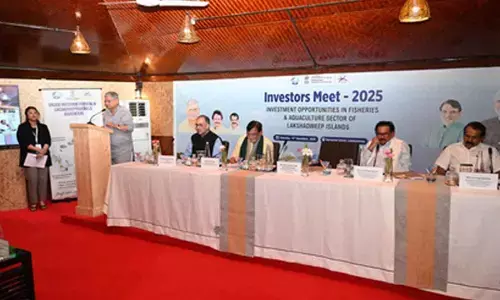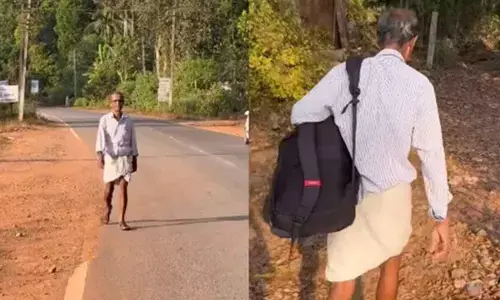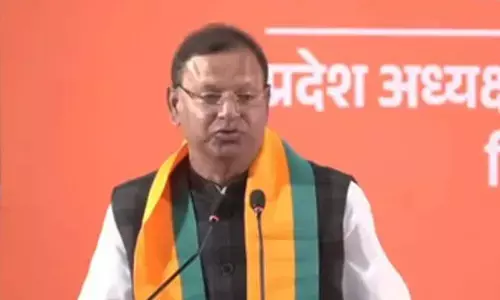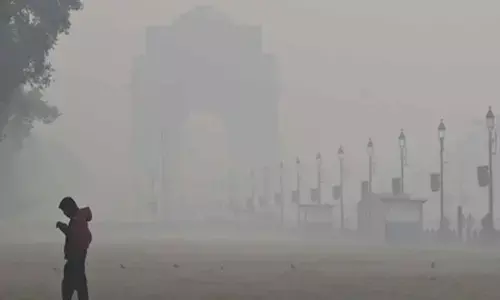MyVoice: Views of our readers 16th July 2023

MyVoice: Views of our readers 15th January 2024
How wonderful it is when cops turn good Samaritans, mentors, motivational speakers and spiritual gurus!
COPS AS GURUS AND GUIDES
How wonderful it is when cops turn good Samaritans, mentors, motivational speakers and spiritual gurus!
In a Telugu movie of 80s,hero Krishna had donned the role of a police officer. In a particular scene while talking with a subordinate officer, Krishna tells him, "Don't become a police officer, be a police officer." So a police officer should always be ready to help people whether in uniform or not, and whether on duty or off duty.
We all know that the job of a policeman is a highly demanding and 24×7 job. Most police personnel work by the rulebook, put lots of efforts to deliver the goods to the people. But a few of them think out of the box and go an extra mile to render some "extra" service to the people.
During the recently held TS Service Commission Exams in Hyderabad, some women candidates had reached a wrong examination centre. On coming to know this, an SI on duty at the centre not only dropped the candidates at their exam centre in his vehicle but also ensured that they were allowed to take the exam. Another woman constable won the appreciation and rewards from her higher-ups when she had saved the life of a swooned woman by performing CPR at the Uppal stadium during a cricket match.That is the real meaning of the dialogue, "Be a police officer" penned by writers 'Paruchuri Brothers'.
Some cops assume for themselves the role of a signboard that helps us reach our destination or goal. Here is a retired cop who has become a 'Spiritual guide' of sorts. DGP Aravinda Rao is writing a weekly spiritual column in The Hans India.Very rarely do we come across a top police cop with such in-depth knowledge about Hindu Scriptures and epics. Reading his informative and educative column in lucid English reminds me of his sister who was an English lecturer and my contemporary in Kadapa. She used to talk about his command and flair for the language.
Yet another IPS officer V V Lashminarayana, popularly known as 'JD' Lashminarayana, opted for voluntary retirement at the age of 53 in 2018. As a popular and powerful motivational speaker, he has so far met and addressed about 30 lakhs of students. Perhaps, he must have taken a cue from the life of A P J Abdul Kalam whose first love was interacting with and guiding the youth of the country and he breathed his last while addressing a students' gathering. Lashminarayana has also adopted three villages and donated blood for 58 times so far.Hats off to this cop who motivates others with his words and deeds.
What if a busy and in-service top cop becomes a mentor for youngsters at a crucial time in their lives! Mahesh M Bhagwat is one such Additional DGP in Hyderabad.Though initially he was an IPS officer in the Manipur-Tripura cadre, Bhagwat came over to the AP cadre in 2016 and since then he has been working in Telangana. He dealt with an iron hand the issue of women trafficking, by rescuing and rehabilitating thousands of women and educating the children of these women.This achievement got for him a medal from the US Government.This may be part of his job.
A striking virtue of this officer is that he has voluntarily taken up the role of a mentor in Hyderabad for hundreds of candidates preparing for the Civil Services Exams. His invaluable tips and suggestions in particular for facing the personality test (the Interview) have helped many candidates in hitting the bull's eye, securing top ranks. He has been doing this 'extra' service free of cost for many years. From his numerous interviews given to news channels, one can understand that Bhagwat is more serious and focused than the candidates in his preparation to be a well-informed mentor. And the number of 'top all indian rank' holders in the exams bears a testimony to that.
The commitment, dedication, and service moto of these officers not only make an inspiring story for all of us but also show the police system in a different light and colour. Let the tribe of these model cops prosper.
– M Somasekhar Prasad, Hyderabad
UCC can help restrict growth of population
It is perplexing to note that India which is a multi-cultural, multi-lingual, multi-ethnic and multi- religious society is home to the 2nd largest population of Muslims (THI, 13-07-2023). According to a recent estimate made by the population wing of UNO, the Indian population has even surpassed that of China. The population of India stands next to no other country at 142.86 crore while that of China is at 142.57 crore. This kind of anomaly is not a surprising phenomenon and is a foregone conclusion. This worrisome population boom in India has set to progressively lead towards an uneven ratio of Hindu and Muslim population of India.
The census which is revived once in every decade has the latest computation made in 2011 due to skipping the same in the pandemic year 2021. As per the exponential growth model, by the year 2021 there was 120.6 crore Hindu population as against the Muslim population that rose to 22.6 crore.
The States of J&K, Assam, W.B., U.P., Bihar and Maharashtra have stood in the forefront in reckoning with Muslim population. As compared to the last 5 decades, Muslim population during 2001-2011 grew to the hilt by crossing 17 crores. There is a freak situation due to the abnormal rise of Muslim population in India. Muslim women have outnumbered in the aspect of giving birth to children due to non-priority and negligence being given to family planning measures by this community whereas Hindu women have been scrupulously adopting family planning norms.
Although several Islamic nations have been implementing family planning measures, Muslims in India are averse to such measures as the elders of Islamic religion are inciting not to adopt family planning thereby resulting in multiplication of population which is a disturbing trend.
The Sachar Committee report had falsely implied that by 2100, Muslim population would reach 17-21% of the total population, whereas it seems to be a reality that Muslim population would rise to 75-90 crore out of the estimated total of 200 crore population by that time. Family planning measures adopted in the country are a bane for Hindus as Islam is totally in negation to adopt such practices to proliferate population explosion .The practice of polygamy among Muslims is also a reason for population growth. Hence, if UCC is made a legislation, it would be possible to plug the loopholes of our social system by providing more options for the majority Hindu population to lead a better lifestyle as well as stabilize Muslim population in the country.
– Bh Indu Sekhar, Hyderabad
Bringing GSTN under PMLA very essential
At the GST (Goods & Services Tax) Council, there is unique phenomenon that there is no direct involvement of the central government and all decisions by the Council. All state governments are represented in it and all decisions are taken in one voice. The first highlight involves the approval of the long-debated decision to impose a 28 per cent tax on gaming firms and casinos. And the second step taken by Council is very important and which will help to boost the economy but in the initial stage there may be opposition from the states which are governed by opposition parties.
The second highlight focuses on the Council's determination to introduce stricter regulations for the indirect tax regime. These measures aim to enhance compliance and curb fraudulent activities within the system. After the meeting, AAP was speaking against PMLA (Prevention of Money Laundering Act), quoting the examples of their ministers Manish Sisodia and Satinder Jain who are already under police custody and in such type of cases opposition parties should not create hurdles and rather they should come forward and help the government agencies. We have also seen bundles of rupees which were captured by Enforcement Directorate from the residence of West Bengal minister.
If such type of happenings is be curbed, why are they protesting to cover GSTN (Goods and Services Tax Network) under the PMLA? PMLA has own significance. The Act was promulgated in 2002 and it defines money laundering as the process of converting unlawfully obtained proceeds into legitimate assets. With the ED being empowered to investigate and prosecute money laundering cases the PMLA acts as a powerful tool in combating financial crimes.
The inclusion of GSTN under PMLA allows the ED to assess information pertaining to GST taxpayers and this information can be instrumental in investigating money laundering cases associated with GST and for instance if there are suspicions that a GST taxpayer is utilising counterfeit invoices to evade taxes, the ED can leverage the information from the GSTN to verify the authenticity of the invoices. The changes to include GSTN under the PMLA have been implemented under Section 66, which deals with the disclosure of relevant information and according to Section 66 of PMLA any individual or organisation possessing information that is pertinent to an investigation under the PMLA is required to disclose that information to the ED and this provision encompasses information held by the GSTN as well.
In line with the notification issued by the government on July 7 2023, the sharing of information has been formalized between the GSTN and the ED. This implies that the GSTN can share information with the ED and if they come across any suspicious foreign exchange transactions or other GST offenses involving any GST assessee. The exchange of information between the GSTN and the ED will strengthen coordination between these entities and facilitate smoother investigations into money laundering cases associated with GST and this step will also serve as a deterrent, discouraging individuals from engaging in such illicit activities. The collaborative efforts of various agencies .facilitated by the integration of GSTN with the PMLA will play a vital role in deterring money laundering activities and ensuring the integrity of the GST system.
This well-intended decision should be complemented with a flexible approach so that registrants don’t have to suffer. The surge in GST collection over the last few months has been an encouraging sign for the Indian government. This surge can be attributed to various reasons such as improved compliance and economic recovery and stricter enforcement measures. The government's efforts to streamline the tax collection process and reduce tax evasion have undoubtedly played a significant role in this positive trend.
– Yash Pal Ralhan, Jalandhar
It’s not advisable to go in for a few big banks
The IBC (Insolvency and Bankruptcy Code) has been established to speed up recovery of overdues in NPAs by banks. But this has not been so useful.
Under the IBC, a compromise settlement is a negotiation-based agreement in which banks agree to forego a part of the sums legitimately due to them in order to obtain some of the expected receipts and closure of the accounts. It may also be viewed that these accounts are fully provided for. The amounts involved are not small, at 15,778 accounts involving Rs 3,40,570 crore. Of these, 45% have been sent for liquidation and others closed with some amount foregone by banks. In the liquidation process, the value was a mere 7% of the claims of banks. This IBC process continues to be slow as in the cases of DRT (Debt Recovery Tribunal) and SARFASI (Securitisation and Reconstruction of Financial Assets and Enforcement of Security Interest Act).
Even in the case that moved to resolution state, the average recovery of the claims by the financial creditor is just 32%. Even this figure was shored up by a handful of cases with good realization. As such what good has been done to banks by establishing IBC? Very little. This percentage of recovery might have been made in the normal recovery adopted by banks. Considering this, the government and RBI brought a new circular permitting compromise settlements in the NPAs and stressed accounts. If banks adopt this circular, it is evident that the borrowers are the beneficiaries rather than lenders.
A compromise settlement is always a loss to the lender as it has to forego the interest on the asset as well as write off of some amount of principal in some cases which is a huge loss to banks and FIs. Ultimately, what may be the government view point is it has to cleanse all the balance sheets of banks with a nil or meagre NPAs and either merge them all into a three or four major banks or it may privatise them.
This view is not only is of the bankers but also the people who have banking knowledge. If this is the case the poor and middle class are worst hit and a big service gap would be visible. At any cost this should be avoided.
– TSN Rao, Hyderabad
Temples of learning
Participating in the centenary function of Gita Press, Gorakhpur, UP, the world's largest publishers of Hindu religious texts, Prime Minister said that they were a living faith, no less than a temple. While I have nothing against what the PM has said, the same year on Vijayadasami Day, one P H Sunderasa Iyer founded a “temple” of learning. This school was first named as Madrasi Education Association Higher Secondary School (MEA) then renamed as Delhi Tamil Education Association Higher School (DTEA Higher Secondary. Iyer who was just 10th pass made up his mind to start the school for Tamilian children whose parents were working in the British government then.
To start a school in north India then was not that easy, but after registering the school in 1919 in Shimla and it was on Vijayadasami Day the hundred-year-old journey began with one teacher and one student. Later, the school moved to Delhi before moving to Reading Road (now known as Mandir Marg). Until 1947, it was the only branch. In 1951, another branch was opened in Delhi’s Lodhi Road, followed by one branch in Pusa Road (near Delhi’s oldest shopping area known as Karol Bagh).
In 1958, a branch in Lakshmibai Nagar (not far off from Luyten’s Delhi where PM and many others reside), the foundation of which was laid by India’s first PM Jawaharlal Nehru. Thereafter branches were added Moti Bagh, RK Puram, Janakpuri and lastly in Mayur Vihar. All put together there are more than 9,000 children from all walks (including north Indians) who are being imparted learning from this temple known as iconic DTEA schools.
The school has produced some of the brilliant students who are shining in various profession including Tennis Player Ramanatha Krishnan (Sr), Bollywood and Kollywood actors like Hema Malini and Sarathkumar (whose father worked as Tamil News Reader at AIR Delhi, India’s first Air Vice Marshal Padmavathy Bandhopadhyay and many others.
Just for the information of PM that if Gita Press is no less than a temple, DTEA group of schools Delhi or other schools are no less than a temple of learning in northern India maintaining the spirit of unity in diversity. After all, without temples of learning none can read or understand the Hindu text printed by Gita Press.
- N Nagarajan, Hyderabad
A tribute to ‘Kavita Srinadha’ Gnanananda Kavi
Suragali Thimothy Gnanananda Kavi was a prominent poet whose vast poetic output and commendable mastery of Telugu prosody earned him encomiums from such gigantic scholars and poets as Kavi Samrat Viswanadha Satyanarayana. No wonder, he was hailed as ‘ Abhinava Joshua ‘ ‘Kavita Srinadha,‘ ‘Kavi Kokila,’ ‘Sahithi Vallabha,’ and ‘Kavi Sarvabhouma’
Born on 22 July, 1922 In a poor Harijan family at Pedapenki near Bobbili, he showed a precocious talent for poetry at the age of nine and made a debut on the literary stage in 1932. But the way to the summits of fame proved formidable for him in the early stages. The caste Hindus and the conservative Christians mocked at the very idea of a Harijan boy gatecrashing into the domain of a privileged few. But an undaunted, Gnanananda Kavi pursued his goal indefatigably and before long claimed his place in the world of Telugu literature.
A prolific poet of such works as Bharata Matha, Probhodam,Vijayabhisekam, Eeswara, Prajaswamyam, Panchajanyam, Golconda,Swechha Geetam, Asha Sandesam, Gandhi, Tagore, ViswaBharathi, Santhi Geetam, Jateeya Samaikyam Parjanyamu, Sahoninadam, Pillamgrovi, Vamsadhara and Sri Vivekananda Ganam, Gnanananda Kavi proved himself indispensable wherever classical Telugu Literature is mentioned and discussed at literary meetings
“Modernity is a question, not of date but of outlook. Gnanananda Kavi took to classical poetry with a view to establishing the truth that progressive human values need not be clothed with the modern uniform of free verse and that they can equally shine through the disciplined form of prosody. It is his conviction that a poet can adopt a form of his own in which he can best express himself.” A single line, laden with poetic splendour and appeal conceals beneath the weight of scholarship of the poet, he opines. A glimpse of his poetic art and vision!
In thematic content and poetic style, Gnanananda Kavi is a worthy follower of such eminent poets as Karuna Sri and Joshua. The compassionate fervour in Karuna Sri and the humanistic idealism of Joshua blend in his poetry, an instance of which is ‘Aradhana.’ In this poem, he castigates the inhumanity of a thankless humanity to all other creatures in nature. One is reminded of the multi-mouthed lamentations of the bleeding flowers in Karuna Sri’s ‘Pushpavilapam.’ His ‘Saho Ninadam’ and ‘Bhavi Bharatam’ are a glowing testimony to his humanistic ideals and poetic integrity. In poem after poem, he calls for a purposive literature which is unstained by false sloganeering and hollow rhetoric and sounds the conch for the liberation of the helpless humanity caught up in the clutches of exploitation of all hues.
‘Amrapaali’ is truly an iridescent piece of poesy which won him the prestigious Sahitya Academy Award and proved his splendorous poetic talent and fecund scholarship. The adroit poetic style and keen analysis of human passions make it a commendable classic apart. His consummate handling of Sringara Rasa reminds the readers of the magnificent romanticism in the works of the masters of yore The Andhra University and Osmania University prescribed ‘Amrapaali’ for degree students. To him, true religion is adherence to the dictates of a pure conscience but not a blind faith in the meaningless ritualism and shallow spiritualism. His ‘Pancha Janyamu’ with its plea for a change of heart and conversion of soul’ in a world of soul scorching materialism shows his anguish over the decline in human values in the modern world. In ‘Esu Christu Satakam’ and ‘Christu Prabhandham,’ he portrays Christ as the protagonist of a revolutionary spiritual movement who laid down his life at the altar of service to humanity. In his ‘Vijayabhisekam,’ he paints the glorious freedom struggle and fondly wishes that the ‘blood, sweat and tears’ of the martyrs had not gone in vain. His vision of an egalitarian society in which the toiling tillers and workers are given their due and exploitation by the feudal lords is ended once and for all quite striking in almost all his works. In appreciation and recognition of his peerless services to the field of Telugu Literature, the Andhra University bestowed upon him the much-coveted ‘Kala Prapoorna’ in 1974. He had also the rare privilege of being honoured with ‘Kanakabhishekam’ in 1974 and felicitated with ‘Gandapenderam’ in 1982. As a member of the Academic Council of Andhra University and Andhra Pradesh Sahitya Academy, Gnanananda Kavi distinguished himself well. The crowning glory of his life was in 2001 when the Government of India honoured him with the prestigious Padma Sri. He richly deserved the praise of Padmabhushan and Jnanapeet awardee Dr C Narayana Reddy who said, “Dr Gnanananda Kavi is a renowned popular poet in word, deed and thought. He reflects the chaste Telugu idiom and dignity. He has inherited the unique poetic virtues of Srinadha and Joshua especially in the field of composing ‘Seesa Padyas.’ Though he passed away two decades ago, he is respectfully enshrined in the hearts of countless Telugus forever.
– S M Kompella, Kakinada
Congress refuses to learn lessons
Refer to the Editorial "Congress shall move on, shed alliance baggage" on14th July 2023. Though Congress is upbeat winning Karnataka, still there is no pro-Congress wave built up in the run-up to elections in five states and Lok Sabha polls. As it is, over-confidence saw the party not only lose badly but its stubbornness with allies in seat-sharing without understanding the ground reality has led to its poor performance. The recent panchayat polls in West Bengal is a classic example where Congress has lost totally the capacity to bargain with allies in the state and Lok Sabha elections.
Knowing well that it is always humble attitude coupled with promises which are attainable only endear a party to the voters in the states, it is high time the Congress party leaders refrain from intemperate remarks that do not augur well, as well as actions that only show that the party is desperate for power in the run-up to the polls. All in all, Congress going alone will not only see party's fortunes dipping further but also the much-talked about unity renders it meaningless.
– K R Srinivasan, Secunderbad
















